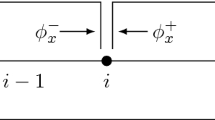Abstract
In this paper, we discuss a new single sweep alternating group explicit iteration method, along with a third order numerical method based on off-step discretization on a variable mesh to solve nonlinear viscous Burgers’ equation subject to given natural boundary conditions. The proposed method is also applicable to both singular and non-singular problems, which is main attraction of our work. The convergence of the proposed method is discussed in detail. We compared the results of proposed iteration method with the results of corresponding double sweep alternating group explicit iteration method to demonstrate computationally the efficiency of the proposed method.
Similar content being viewed by others
References
Keller H.B.: Numerical Methods for Two Point Boundary Value Problems. Blaisdell Pub. Co., Massachusetts (1968)
Evans D.J.: Parallel strategies for linear systems of equations. Int. J. Comput. Math. 81, 417–446 (2004)
Evans D.J.: Iterative methods for solving non-linear two point boundary value problems. Int. J. Comput. Math. 72, 395–401 (1999)
Evans D.J.: The solution of periodic parabolic equations by the coupled alternating group explicit (CAGE) iterative method. Int. J. Comput. Math. 34, 227–235 (1990)
Evans D.J.: Group explicit methods for solving large linear systems. Int. J. Comput. Math. 17, 81–108 (1985)
Evans D.J., Mohanty R.K.: Alternating group explicit method for the numerical solution of non-linear singular two point boundary value problems using a fourth order finite difference method. Int. J. Comput. Math. 79, 1121–1133 (2002)
Mohanty R.K., Evans D.J.: Highly accurate two parameter CAGE Parallel Algorithms for non-linear singular two point boundary value problems. Int. J. Comput. Math. 82, 433–444 (2005)
Mohanty R.K.: A family of variable mesh methods for the estimates of (du/dr) and solution of non-linear two point boundary value problems with singularity. J. Comput. Appl. Math. 182, 173–187 (2005)
Mohanty R.K.: A class of non-uniform mesh three point arithmetic average discretization for y′′ = f(x, y, y′) and the estimates of y′. Appl. Math. Comput. 183, 477–485 (2006)
Mohanty R.K., Khosla N.: Application of TAGE iterative algorithms to an efficient third order arithmetic average variable mesh discretization for two-point non-linear boundary value problems. Appl. Math. Comput. 172, 148–162 (2006)
Chawla M.M., Shivkumar P.N.: An efficient finite difference method for two-point boundary value problems. Neural Parallel Sci. Comput. 4, 387–396 (1996)
Sukon K.S., Evans D.J.: Two parameter AGE(TAGE) method for the solution of a tri-diagonal linear system of equations. Int. J. Comput. Math. 60, 265–278 (1996)
Mohanty R.K., Sachdev P.L., Jha N.: TAGE Method for nonlinear singular two point boundary value problems using a fourth order difference scheme. Neural Parallel Sci. Comput. 11, 281–287 (2003)
Evans D.J., Jain P.: The coupled reduced alternating group explicit (CRAGE) method. Parallel Algor. Appl. 2, 193–208 (1993)
Feng, Q.: Explicit finite difference method for convection–diffusion equations. In: Proceedings of the World Congress on Engineering, London, pp. 1094–1097 (2009)
Zheng, B., Feng, Q.: Parallel finite difference method for diffusion equations. In: Proceedings of the 15th American Conference on Applied Mathematics, pp. 60–62 (2009)
Evans, D.J., Sahimi, M.S.: The Alternating Group Explicit (AGE) iterative method for solving parabolic equations, 1–2 dimensional problems. Int. J. Comput. Math. 24, 250–281 (1988)
Author information
Authors and Affiliations
Corresponding author
Rights and permissions
About this article
Cite this article
Talwar, J., Mohanty, R.K. A Single Sweep AGE Algorithm based on Off-Step Discretization for the Solution of Viscous Burgers’ Equation on a Variable Mesh. Math.Comput.Sci. 9, 85–103 (2015). https://doi.org/10.1007/s11786-014-0194-9
Received:
Revised:
Accepted:
Published:
Issue Date:
DOI: https://doi.org/10.1007/s11786-014-0194-9
Keywords
- Two point nonlinear boundary value problems
- Off-step discretization
- Variable mesh
- Singular equation
- Single Sweep AGE method
- Burgers’ equation




